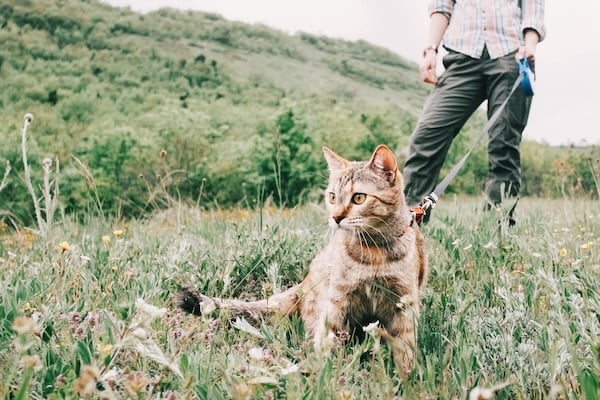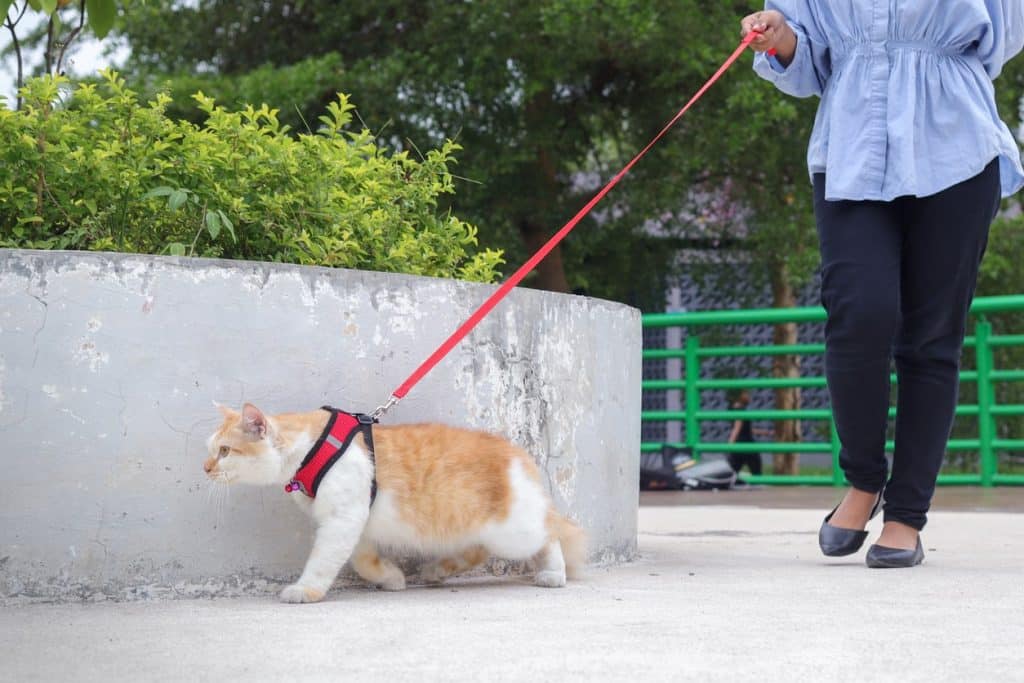- Not a substitute for professional veterinary help.
If you and your cat have ever experienced envy after spotting a dog walking blissfully alongside their human, there’s good news. Cat walking is an option!
Like dogs, cats need daily mental and physical stimulation. Without enough of it, they can become bored, overweight, or even destructive. Training your cat to walk on a leash can be a great way to bond and to provide them with enrichment.
That said, leash walks aren’t for every cat, and the process of helping them stay comfortable and safe can require a lot of patience. But it’s not cruel, according to Joey Lusvardi, certified cat behavior consultant and founder of Class Act Cats. He says that putting a cat on a leash can be more than okay, and he has some key tips to help you along the way.
Should I Walk My Cat?
While many cats are content sunbathing, they’re also natural explorers who need to exercise their bodies and brains. Experts recommend that indoor cats get at least 30 minutes of daily exercise with their humans. Walking is a great way to meet that need.
As Lusvardi explains, “It gives your cat a chance to use all of their senses, especially their sense of smell, in a way that’s challenging to replicate indoors.”
Mary Molloy, an animal behavior counselor and founder of Nirvana Tails, agrees. “Going for walks outside can be incredible mental and physical enrichment for indoor-only cats,” she says.
Of course, not all cats are suited for walks.
“One of the biggest keys to whether a cat will enjoy the outdoors is if they can not only tolerate but enjoy wearing a harness and leash,” says Lusvardi. “If your cat spends the entire time trying to get out of the harness, that’s not enriching to them. You’re just causing them more stress!”
Lusvardi says that cats may do well outside when they’re:
- High energy
- Generally confident
- Comfortable on a leash
Most pet parents don’t know if their cat will be comfortable on a leash until they try. Your cat’s success in this area largely depends on their personality and your approach to training.
Some cat breeds are known for being more outgoing, curious, or water-loving than others, which may make them more accepting of leash training. These often include larger or more active breeds such as Bengals, Savannahs, Norwegian Forest Cats, Maine Coons, and Turkish Angoras.
In contrast, cats may struggle on a walk if they are:
- Uncomfortable on a leash, even with training
- Skittish
- Fearful of dogs or other cats
If your cat isn’t likely to be successful on a walk, don’t worry. Cat walking isn’t the only solution for exercise and mental stimulation. There are other fun options to ensure your cats get the exercise and stimulation they need.

Remains via iStock
Step-by-Step Guide to Cat Walking
To train a cat to walk on a leash, break the process into four parts:
- Familiarizing your cat with a harness
- Teaching your cat to walk on a leash in a safe environment
- Transitioning to outdoor walks
- Getting them comfortable with a cat backpack
Harness & leash training
The first step to walking your cat is familiarizing them with a harness and leash, says Lusvardi.
“This should be done slowly and in a fun, positive manner,” he explains. “Simply shoving it on your cat is going to create an aversion, so you need to go at their pace.”
- Put the harness on the floor and allow your cat to explore it. Reward them with treats or praise as they approach it and interact with it, like sniffing it or playing with it.
- Pet your cat with the harness in your hand. If the harness makes any sounds (like a snap or Velcro), immediately reward your cat with a treat or praise. Repeat this process until your cat shows no negative reaction to the sounds or touch of the harness
- Put the harness on your cat. Have your cat wear their harness indoors for short periods, gradually increasing the duration. Don’t be surprised if your cat freezes or flops over at first. Use a positive tone (and tasty treats) to show them it’s not scary.
- Encourage your cat to do fun things while wearing their harness, like play or eat a meal.
You’ll follow the exact same process for leash training, introducing the leash separately in steps one and two, then attaching it to the harness for steps 3 and 4.
Walking on leash in the house
Once your cat is comfortable with a harness and leash, you can start to lead them in a walk. Lusvardi recommends that you begin at home, where your cat is most comfortable.
If you’re used to walking a dog, the experience of walking a cat may be frustrating at first. “Cats will often meander more and spend a lot of time sniffing,” says Lusvardi. “There may be more standing around for you, and you’ll likely go slower than a dog walk. That doesn’t mean it’s not enjoyable for the cat!”
Outside training
When your cat is comfortable walking on a leash inside, you can move outside—but not too far outside. “If you live in an apartment complex, you can start with the halls,” Lusvardi explains. “Otherwise, stick to the yard to start.”
As you venture further and further from home, avoid busy parks, streets with traffic, or wide-open spaces that might feel overwhelming. Keep every new experience brief and positive, gradually increasing the walking distance to help your cat slowly adjust.
Let your cat decide the pace and direction of exploration. This might mean not going very far, but it will help them feel in control, which cats love.
Backpack training
Cat backpacks are handy for two reasons. If your kitty is more comfortable as a passenger than a walker, cat backpacks allow them to safely explore the world around them without actually putting their paws on the ground. They’re also great as a backup for a cat who becomes overwhelmed or decides that they’re tired mid-way through a walk.
For your cat’s backpack, you’ll follow a similar process that you used for the harness and leash:
- Leave your cat’s backpack out in the house and let them explore it. Your cat might find that it’s a safe, cozy place to nap. Encourage them to jump into their backpack with the help of clicker training and/or cat treats.
- Take your cat for a test drive in the house. Once your cat is hopping into the backpack on their own, try picking it up for brief periods, rewarding regularly. Start with tiny increments, then slowly increase the length of time your cat spends as a passenger.
- Try an outing outside the house. Start with quick trips to the yard, then short walks around the block, monitoring your cat’s level of comfort and rewarding regularly.
-
iStock/Yazid Nasuha
Troubleshooting
Walking a cat comes with some unique challenges. Here’s what you can do.
Avoiding door dashing
If you’re worried that walks will encourage your cat to sprint out the door, teach your cat to sit at a designated spot before clipping on the leash.
Then pick up your cat and set them outside or place them in their backpack to carry them out the door, rather than allowing them to cross the threshold themselves. This shows your cat that you’re in control of how and when they leave the house.
Preventing negative encounters
“Cats may encounter animals or, unfortunately, people that are hostile toward them,” says Lusvardi. “If safe to do so, putting yourself between your cat and the animal can shield their view of each other. If you’re worried, grab your cat and calmly go in the other direction.”
Lusvardi recommends scouting the area without your cat before you go out together. Look for potential dangers, including the number of dogs out and about at various times, as well as the foliage. “Pay attention to any plants or other items on the ground to prevent them from being injured or ingesting something toxic,” Lusvardi recommends.
Tips & tricks
Here are some additional tips to ensure your walks together go smoothly.
- Be patient. Revisit training steps if needed and reward positive experiences.
- Create a routine. Familiar routes and routines can help your cat know what to expect.
- Respect your cat’s limits. Don’t force your cat to walk when they don’t want to or to go farther than they’d like. “Keep an eye on your cat’s body language and if they seem distressed, consider ending the walk,” says Lusvardi.
- Bring your cat backpack. Offer a lift when your cat needs a break, feels overstimulated, or gets spooked.
- Reward success. Use treats and praise to keep your cat motivated.
- Choose the right weather. Opt to walk on days with ideal weather, and avoid bad conditions.
Taking your cat for a walk is about enjoying the experience together, not necessarily reaching a destination. But if you’re struggling or concerned, a veterinarian or cat behaviorist can assess your cat’s temperament and provide personalized training plans that can be used on and off the trail.
Cat Walking Starter Pack
To successfully walk a cat, you’ll need more than a leash and a collar. In fact, you should never connect a leash to a cat’s collar. Collars can put strain on a cat’s neck and can easily slip off. Instead, invest in a high-quality cat harness.
“The harness should be comfortable for your cat, as your goal is to walk them loosely, not pull on them. The harness really is meant to be more of an emergency stop,” says Lusvardi. “Cats tolerate different styles of harnesses, so strike a balance between comfort and how easy it is to get on and off your cat.”
Here’s a full cat-walking supply list to get you started.
- Harness. The best cat harness is comfortable, escape-proof, and fits snugly without restricting movement.
- Leash. Choose a non-retractable cat leash that allows enough length to give your cat some freedom while keeping them safe.
- Collar and ID tag. Ensure your cat wears a collar with an up-to-date ID tag at all times.
- High-reward treats. Cat training treats reinforce good behavior on walks. As Lusvardi reminds us, cats are more open to learning new things when rewards are at stake—and treats can double as a distraction in a sticky situation.
- Water. If you’re going to be out for a while, make sure to bring a pet water bottle or travel bowl.
- Cat backpack. Backpacks provide a safe haven for your cat during your walk and in the car, if you travel to your walking destination.
- First-aid kit. Be ready with the basics to quickly treat minor injuries.
- Towel. A soft towel can make scooping up a scared or injured cat easier and safer.
- Vaccinations. Ensure your cat has all the vaccinations they need plus flea and tick prevention for safe outdoor exploration in your area.
“While not directly related to the walk itself, make sure your cat is microchipped,” adds Lusvardi. “Even well-designed harnesses and high-quality leashes can break. If your cat gets away, a microchip will help them be more likely to return home.”
Alternatives to Walking Your Cat
Some cats may find the outdoors overwhelming and prefer the comfort of their familiar life indoors. If your kitty falls in the latter category, look for activities that provide the same benefits.
“A lot of the benefits to walking involve allowing a cat to engage in normal cat behaviors and get mental stimulation,” says Lusvardi. “Regular play sessions with your cat that imitate a hunt can help reduce boredom and provide exercise.”
Lusvardi recommends trying nosework and other enrichment exercises based in scent. You can also use cat-safe plants like catnip or cat grass to bring the outdoors in, or even clicker training to give your cat the stimulation they need.
Other good forms of enrichment and exercise include:
Before you give up on walking your cat, though, it’s also helpful to remember that taking your cat for a walk is about enjoying the experience together—not necessarily reaching a destination. Whether you walk your cat on a leash or engage in one of these alternate activities, make sure it’s something that you can both enjoy.




